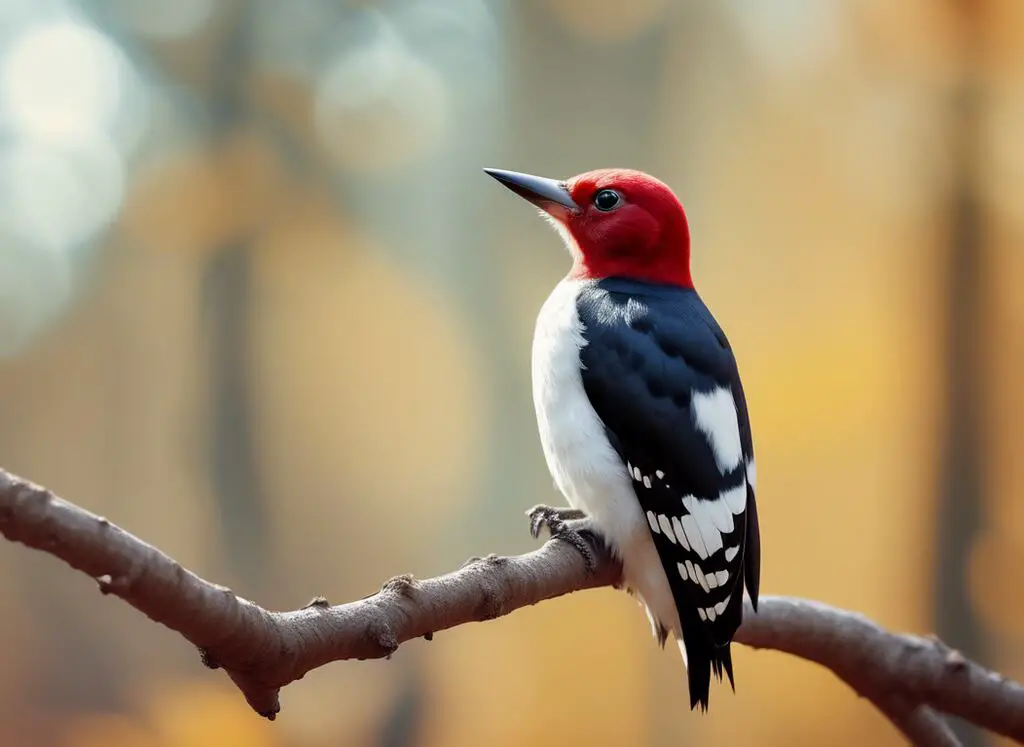Welcome to a delightful journey into the world of the Red-Headed Woodpecker! Get ready to be enthralled as we uncover a treasure trove of fascinating facts about this striking bird. From its vibrant plumage to its unique behaviors, we’ll explore the wonders of nature through the lens of this iconic woodpecker species. Join us as we dive into the forest realm and discover the delightful secrets of the Red-Headed Woodpecker!
Table of Contents
- 1 Key Takeaways
- 2 Identifying The Red-headed Woodpecker
- 3 Distribution Range
- 4 Habitat
- 5 Food Sources
- 6 Migration
- 7 Nesting And Reproduction
- 8 Calls And Songs
- 9 Social Behavior
- 10 Predators
- 11 Attracting Them to Your Yard
- 12 Interesting Red-headed Woodpecker Facts
- 13 Frequently Asked Questions
- 13.1 What is the lifespan of a red-headed woodpecker?
- 13.2 Do red-headed woodpeckers migrate long distances?
- 13.3 How do red-headed woodpeckers communicate with each other?
- 13.4 Can red-headed woodpeckers be found in urban areas?
- 13.5 Why are Red-headed Woodpeckers important?
- 13.6 Is a Red-headed Woodpecker rare?
- 13.7 Are red-headed woodpeckers considered threatened or endangered?
- 14 Conclusion
- 15 Author
Key Takeaways
- The red-headed woodpecker is a species found in North America.
- Its coloration is the result of a genetic mutation.
- The woodpecker is known for its acrobatic foraging behavior and drumming.
- The species is a conservation concern due to habitat loss and its population has declined in recent years.
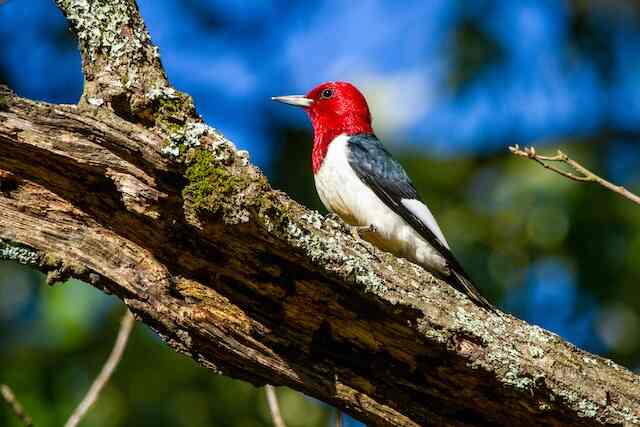
Identifying The Red-headed Woodpecker
The Red-headed Woodpecker (Melanerpes erythrocephalus) stands out with its vibrant red-head, contrasting black-and-white body, and a sturdy bill.
Its distinct appearance and unique coloration make it easily recognizable among other woodpecker species.
With a predominantly black body, white wing patches, and a white belly, this bird exhibits a striking contrast. Its chisel-like bill is perfect for excavating tree cavities.
Overall, the Red-headed Woodpecker’s physical features contribute to its captivating and visually appealing presence in nature.
| Red-headed Woodpecker | Facts |
|---|---|
| Scientific Name | Melanerpes erythrocephalus |
| Size | Approximately 7-9 inches (18-23 cm) in length |
| Wingspan | Approximately 16-17 inches (41-43 cm) |
| Weight | Around 2.5-3.5 ounces (70-100 grams) |
| Coloration | Bold black and white plumage with a solid red head and neck |
| Habitat | Deciduous forests, woodlands, orchards, and open areas with scattered trees |
| Range | Found in eastern and central parts of North America |
| Diet | Omnivorous, feeding on insects, fruits, nuts, seeds, and occasionally small vertebrates |
| Behavior | Agile climbers and active foragers, known for storing food in tree crevices |
| Conservation Status | Near Threatened, with population decline due to habitat loss and competition |
| Unique Features | Striking redhead and contrasting black and white body markings |
| Vocalizations | Varied calls and drumming sounds |
| Nesting | Excavates nest cavities in dead trees, often reusing old nesting sites |
| Breeding Season | Typically from late April to early July |
| Lifespan | Up to 9-12 years in the wild |
*Please note that the information provided is a general overview and may vary slightly depending on specific geographic regions and individual observations.
Unique features
Contrasting against its crimson crown, the red-headed woodpecker’s black and white feathers create a striking visual display that demands attention. This unique coloration is not the only interesting feature of the red-headed woodpecker.
Here are four key aspects of its behavior, adaptations, conservation, population, and evolution:
- Red-headed Woodpecker Behavior: These woodpeckers are known for their acrobatic foraging behavior, often clinging to tree trunks and branches while searching for insects. They also engage in drumming behavior on resonant surfaces to communicate with other woodpeckers.
- Red-headed Woodpecker Adaptations: Their strong beaks are adapted for pecking and drilling into wood, allowing them to excavate nest cavities and find food. They also have specialized shock-absorbing tissues in their skulls to protect their brains during intense drumming.
- Red-headed Woodpecker Conservation: The red-headed woodpecker is considered a species of conservation concern due to habitat loss and degradation. Efforts are being made to preserve and restore their preferred habitats.
- Red-headed Woodpecker Population: The population of red-headed woodpeckers has declined in recent years, primarily due to habitat loss and competition with other cavity-nesting species.
- Red-headed Woodpecker Evolution: The red-headed woodpecker is believed to have evolved its unique coloration as a form of visual communication, possibly to attract mates or establish territories.
With its striking appearance and fascinating behaviors, the red-headed woodpecker is a captivating species. Let’s move on to the next section about ‘distribution range’, we will explore where they can be found.
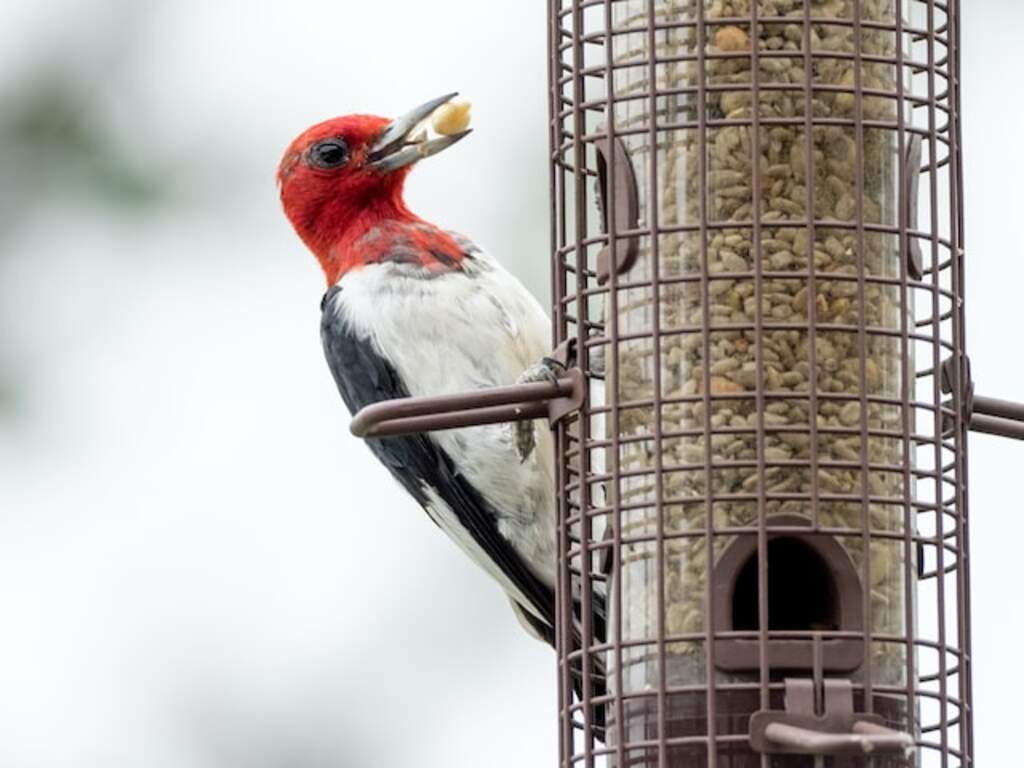
Distribution Range
The red-headed woodpecker is a species that has a wide geographical distribution across North America. It is found in various habitats including forests, woodlands, and open areas such as farmlands and orchards.
This woodpecker species is native to North America and its range extends from southern Canada to the southern United States.
Geographical distribution
Red-headed woodpeckers have a wide geographical distribution throughout North America. Historically, their range extended from the eastern coast of the United States to the Great Plains and as far north as Canada.
However, recent population trends indicate range expansion into new areas, possibly as a result of conservation efforts and habitat restoration.
Climate change may also play a role in their distribution, as it can affect the availability of suitable habitats.
Human interaction, such as deforestation and urbanization, can have negative impacts on their populations by reducing suitable habitats.
Understanding the geographical distribution of red-headed woodpeckers is important for conservation efforts and to assess the impact of climate change on this species.
Transitioning into the subsequent section, it is also crucial to explore their native habitats for a comprehensive understanding of their ecology.
Native habitats
Native habitats for the red-headed woodpecker include a variety of forested areas, such as deciduous and mixed forests, as well as open woodlands and savannas. These habitats provide the necessary resources for the woodpecker’s survival.
Native plants, such as oak trees, hickory, and beech, are important food sources for the red-headed woodpecker, as they produce an abundance of acorns and insects.
Conservation efforts have focused on maintaining and restoring these native habitats to ensure the woodpecker’s population thrives.
Unfortunately, population trends for the red-headed woodpecker have shown a decline in recent years, mainly due to habitat loss and fragmentation.
Despite this, the woodpecker’s nesting behavior and courtship displays remain unchanged, with males drumming on dead trees to establish territories and attract mates.
Transitioning to the subsequent section about ‘habitat,’ it is essential to understand the specific requirements for red-headed woodpeckers to thrive in their natural environment.
Habitat
The red-headed woodpecker is known to thrive in a variety of ecosystems across North America. However, it is most commonly found in open woodlands, mature forests, and mixed habitats with a mixture of trees and open spaces.
These habitats provide the necessary resources for the woodpecker, including suitable nesting sites and an abundant supply of food, such as insects, fruits, nuts, and seeds.
The presence of dead trees or snags is particularly important for this species, as they are used for nesting and foraging.
Preferred ecosystems
Woodpeckers are most commonly found in mature deciduous forests and open woodlands. They have a preference for ecosystems that offer a combination of tree species, particularly those with high densities of dead or decaying trees.
These habitats provide an abundant supply of food sources for the red-headed woodpecker, including insects, larvae, and tree sap.
The woodpecker’s foraging behavior involves pecking at the bark and drilling into the wood to extract food.
Additionally, they often store food in tree crevices or hide it under loose bark for future consumption.
These preferred ecosystems offer the necessary resources and suitable conditions for the red-headed woodpecker to thrive.
Moving on to habitat requirements, mature forests, and open woodlands provide the ideal environment for this species to meet their needs for nesting, roosting, and foraging.
Habitat requirements
Mature forests and open woodlands provide the necessary conditions for the red-headed woodpecker to thrive, acting as a natural pantry filled with an abundant supply of food and shelter options.
The red-headed woodpecker is commonly found in mature forests, which offer a diverse range of tree species and sizes.
These forests provide an ample supply of dead trees, which the woodpecker relies on for nesting and foraging.
Additionally, the forest edge, where mature forests meet open woodlands, provides an ideal habitat for the red-headed woodpecker as it offers a mix of both forest and open habitat characteristics.
The woodpecker is particularly attracted to areas with tree cavities, which it uses for nesting and roosting.
These habitat requirements ensure that the red-headed woodpecker has access to suitable food sources and nesting sites, facilitating its survival and reproduction.
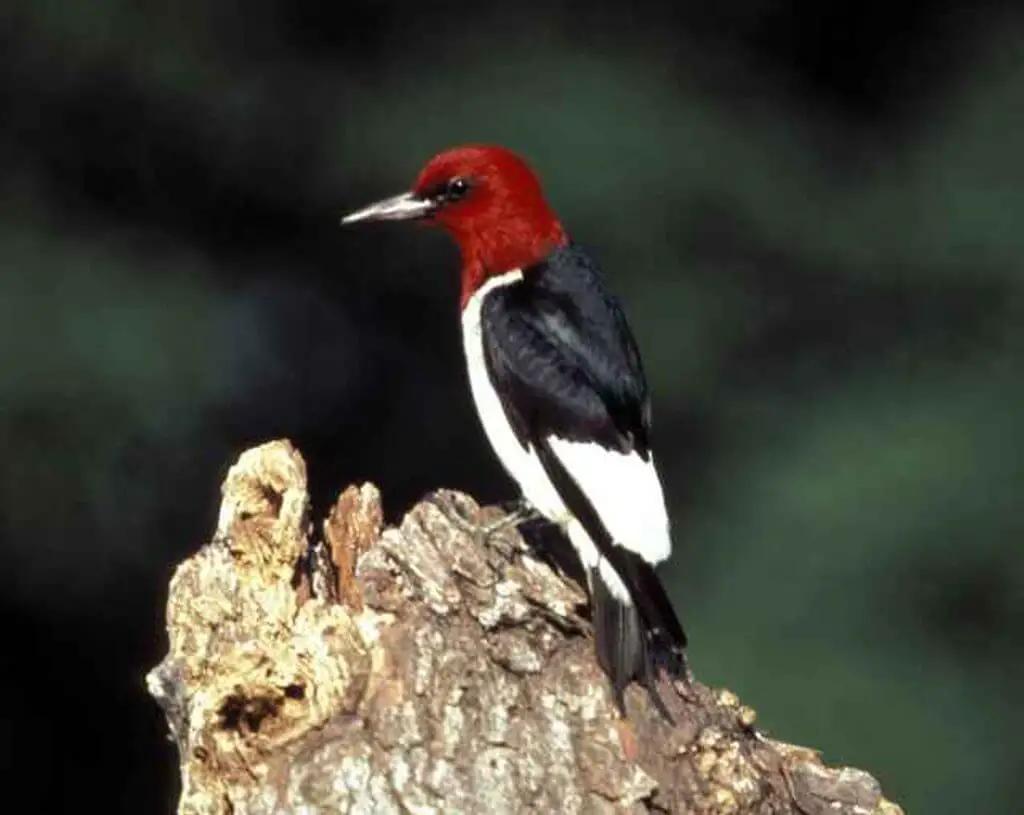
Food Sources
The red-headed woodpecker has a diverse diet that includes insects, nuts, berries, and fruit. Insects make up a significant portion of their diet, with wood-boring beetles being a preferred food source.
They also consume acorns, beechnuts, and other nuts, as well as berries and fruits when available.
In terms of foraging behavior, red-headed woodpeckers are known for their ability to catch insects in mid-air and their habit of storing food in tree cavities or crevices for later consumption.
Diet preferences
Notably, red-headed woodpeckers demonstrate a diverse diet that includes insects, nuts, berries, and even small amphibians. Their insect diet consists of various species, such as beetles, ants, and caterpillars.
As for nut preferences, they particularly enjoy acorns, hickory nuts, and beechnuts. Berries, such as blackberries and elderberries, are also a part of their diet, providing them with additional nutrients.
To obtain their food, red-headed woodpeckers employ different hunting techniques, including pecking, probing, and gleaning.
They use their strong bills to break open tree bark and search for insects, while also exploring the ground for nuts and berries.
Their feeding habits are characterized by their ability to catch insects in mid-air and their knack for storing food in tree crevices or hiding it under loose bark.
Transitioning to the subsequent section about foraging behavior, red-headed woodpeckers display remarkable efficiency in locating and securing their food sources.
Foraging behavior
One intriguing aspect of red-headed woodpeckers is their efficient foraging behavior, which involves employing various hunting techniques and storing food in strategic locations.
These woodpeckers have a diverse diet, including insects, nuts, berries, and occasionally small vertebrates. They are skilled hunters and use a combination of techniques to capture their prey.
For example, they will peck at tree bark to uncover insects or use their strong beaks to extract larvae from decaying wood.
Additionally, red-headed woodpeckers are known for their ability to store food for later consumption. They often wedge acorns or other nuts into crevices in trees or hide them in tree cavities.
This resource utilization strategy allows them to have a steady food supply during periods when food is scarce.
Their foraging behavior and food preferences are essential for their survival and reproduction.
Transitioning into the subsequent section about migration, red-headed woodpeckers rely on their foraging skills to build up energy reserves before embarking on long-distance migrations.
Migration
Migration is a phenomenon observed in many bird species, including the red-headed woodpecker. These birds undertake seasonal movements in response to changing environmental conditions and food availability.
The migratory patterns of red-headed woodpeckers are well-studied, with individuals typically moving southward in the fall and returning northward in the spring, following a predictable route.
Seasonal movements
Seasonal movements of red-headed woodpeckers are akin to a well-choreographed ballet, as these vibrant birds gracefully traverse vast distances in search of favorable habitats throughout the year.
Their migration patterns are closely tied to the availability of food and suitable nesting sites.
During the breeding season, red-headed woodpeckers establish territories and engage in courtship displays, signaling their readiness to mate.
They construct their nests in dead trees or sometimes use existing cavities.
When it comes to foraging, these woodpeckers exhibit diverse strategies, including catching insects in mid-air, probing tree bark for hidden insects, and occasionally feeding on fruits and seeds.
Socially, red-headed woodpeckers are known to be aggressive towards other birds, defending their territories vigorously.
These observations on their seasonal movements lay the foundation for understanding their migratory patterns in the subsequent section.
Migratory patterns
The migratory patterns of red-headed woodpeckers are a testament to their adaptability and resourcefulness as they navigate vast distances in search of suitable habitats and abundant food sources throughout the year.
These birds breed in deciduous forests across North America, primarily in the eastern and central regions.
During the winter months, they migrate to the southern United States and Mexico, where they can find milder climates and a variety of food sources.
Along their migratory routes, red-headed woodpeckers make use of stopover sites, where they rest and refuel before continuing their journey.
The timing of migration varies depending on factors such as food availability and weather conditions.
Understanding the factors influencing these migratory patterns is crucial for the conservation and management of red-headed woodpecker populations.
Transitioning to the subsequent section about nesting, the selection of suitable nesting sites is an important step in the breeding process for these birds.
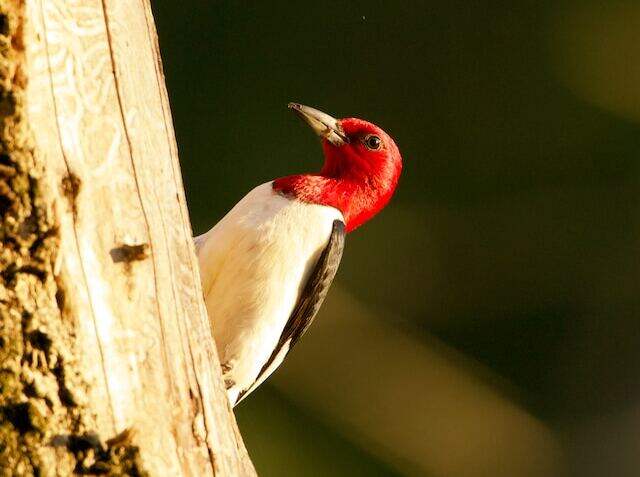
Nesting And Reproduction
Nesting is a critical aspect of the red-headed woodpecker’s life cycle. These birds construct elaborate nests in tree cavities, which provide shelter and protection for their young.
The nest construction process involves excavating a hole in a dead or decaying tree trunk, and lining it with soft materials such as leaves, grass, or feathers.
The red-headed woodpecker exhibits monogamous breeding habits, with pairs forming long-term partnerships to raise their offspring.
During the breeding season, males engage in courtship displays to attract females, and both parents take turns incubating the eggs and feeding the hatchlings.
The reproduction cycle of the red-headed woodpecker is characterized by a single brood per year, with females typically laying 4–7 eggs.
The incubation period lasts about two weeks, after which the hatchlings are cared for by both parents until they fledge the nest in about three weeks.
Nest construction
Remarkably, red-headed woodpeckers exhibit an exceptional talent for architectural craftsmanship as they meticulously construct their nests with the precision of a skilled carpenter.
Nest construction is an integral part of their nesting behavior, which involves various stages such as nest site selection, gathering nesting materials, and competing with other bird species for suitable nesting sites.
Red-headed woodpeckers typically select dead or decaying trees for their nest sites, preferably in open habitats near water sources.
They excavate cavities in the trees using their powerful bills, creating a secure and snug space for their eggs and young.
These cavities are lined with wood chips and other soft materials to provide insulation and comfort.
The success of nesting is influenced by factors such as predator presence, weather conditions, and the availability of suitable nesting sites.
Transitioning to the subsequent section about breeding habits, the red-headed woodpecker’s nest construction skills contribute to their overall reproductive success.
Breeding habits
Astonishingly, the red-headed woodpecker’s breeding habits reveal a complex and strategic approach towards ensuring the survival of their offspring.
During the breeding season, these woodpeckers engage in courtship displays to attract potential mates.
These displays involve drumming on trees and other objects to create a distinct sound that serves as a form of communication.
Mate selection is based on factors such as physical fitness, territory quality, and overall compatibility.
Once a pair has formed, they search for suitable nesting sites, often choosing dead trees or utility poles.
The female woodpecker takes the lead in excavating the nest cavity, which can take several weeks to complete.
After hatching, both parents actively participate in chick rearing, taking turns to feed and care for the young. This intricate system of breeding ensures the survival and success of their offspring.
Transitioning into the subsequent section about the ‘reproduction cycle,’ it is fascinating to explore the different stages that follow this complex breeding process.
Reproduction cycle
The reproduction cycle of the red-headed woodpecker unfolds like a carefully choreographed dance, with each stage seamlessly leading into the next, ensuring the continuation of their species.
Breeding season usually begins in late spring or early summer, when pairs form and establish territories.
Mating rituals involve elaborate displays of courtship behaviors, such as drumming on trees and vocalizations.
Once copulation occurs, the female lays a clutch of 4-7 eggs in a cavity excavated by the male. The incubation period lasts about two weeks, during which both parents take turns keeping the eggs warm.
After hatching, the chicks are altricial, meaning they are naked, blind, and helpless. They rely on their parents for food and protection.
Over the next few weeks, the chicks develop feathers and grow rapidly. Parental care continues until the young leave the nest.
Transitioning into the subsequent section about ‘calls and songs’, these vocalizations play a crucial role in communication among red-headed woodpeckers.
Calls And Songs
Calls and songs play a crucial role in the communication behaviors of red-headed woodpeckers.
Vocalizations are an important form of communication for these birds, allowing them to establish territories and attract mates.
Red-headed woodpeckers have a variety of calls and songs, including a distinctive ‘wick-a-wick-a-wick’ call and a trilling song, which they use to communicate with other members of their species.
These vocalizations provide valuable insights into the social dynamics and behaviors of red-headed woodpeckers.
Vocalizations
Red-headed woodpeckers communicate through a variety of vocalizations. Vocalizations play a crucial role in songbird communication, allowing individuals to convey information to their conspecifics.
Bird calls are short, simple sounds used for basic communication, such as maintaining contact with other members of their group or alerting others to potential threats.
Red-headed woodpeckers produce a range of calls, including contact calls, alarm calls, and territorial calls.
These vocal behaviors serve important functions in their social interactions and help them establish and defend their territories.
Avian sounds are produced by specialized vocal organs and can vary in pitch, duration, and intensity.
Understanding the vocal repertoire of red-headed woodpeckers provides insights into their behavior and social dynamics.
In the subsequent section about communication behaviors, we will explore their non-vocal communication strategies.
Communication behaviors
Communication behaviors in red-headed woodpeckers encompass a range of non-vocal strategies that are essential for their social interactions and territorial defense.
These birds employ various communication methods to convey information to conspecifics.
Courtship rituals involve intricate displays of behavior, such as wing flashing and head bobbing, which serve to attract potential mates.
When engaging in territorial disputes, red-headed woodpeckers use aggressive posturing, including bill-pointing and wing spreading, to establish dominance and protect their territory.
Vocal duets are another form of communication used by these woodpeckers, with males and females engaging in synchronized vocalizations to strengthen pair bonding and defend their shared territory.
In addition to vocalizations, red-headed woodpeckers also utilize nonverbal cues, such as body movements and postures, to convey information to other individuals.
These communication behaviors play a crucial role in the social dynamics of red-headed woodpecker populations, facilitating successful interactions and maintaining territorial boundaries.
Transitioning into the subsequent section about social behavior, these communication strategies are closely intertwined with the overall social behavior of red-headed woodpeckers.
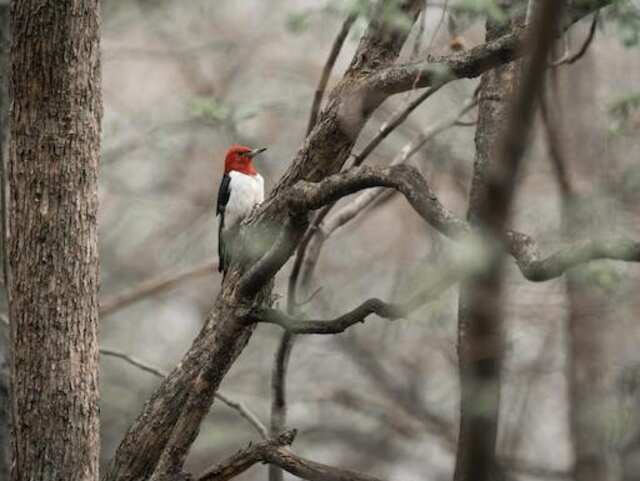
Social Behavior
Social behavior in red-headed woodpeckers includes interaction with other woodpeckers and group dynamics.
Red-headed woodpeckers often engage in territorial disputes with other woodpeckers, particularly during the breeding season.
They are known to vigorously defend their nesting sites and foraging areas against intruders.
Additionally, red-headed woodpeckers may form loose groups or colonies, especially during the non-breeding season, where they engage in cooperative foraging and communicate through various vocalizations and physical displays.
These social interactions play a crucial role in the establishment and maintenance of their territories and may provide benefits such as increased foraging efficiency and enhanced predator defense.
Interaction with other woodpeckers
Woodpeckers of different species often interact with each other, forming complex dynamics within their shared habitat.
Interactions with other woodpeckers involve various aspects such as competition dynamics, cooperative foraging, territorial disputes, hybridization, and species coexistence.
Competition dynamics occur when woodpeckers compete for limited resources such as food, nesting sites, or territory.
This competition can lead to aggression and territorial disputes between individuals of the same or different species.
However, woodpeckers also engage in cooperative foraging, where they form mixed-species foraging flocks to increase their foraging efficiency.
Additionally, hybridization events have been observed between some woodpecker species, resulting in the formation of hybrid individuals.
These interactions and dynamics contribute to the overall group dynamics of woodpecker populations, which will be further explored in the subsequent section.
Group dynamics
Group dynamics in woodpecker populations involve complex interactions and behaviors that contribute to the overall functioning and cohesion of the group, illustrating the intricate nature of their social structures.
- Conflict resolution: Woodpeckers engage in various displays and vocalizations to resolve conflicts within the group, such as aggressive posturing and drumming patterns.
- Power dynamics: Dominance hierarchies exist within woodpecker groups, with individuals establishing their rank through physical displays and contests.
- Communication styles: Woodpeckers use a combination of vocalizations, drumming, and body language to communicate with other group members, conveying information about territorial boundaries, food availability, and potential threats.
- Decision-making processes: Group decisions, such as choosing a nesting site or foraging area, are often made through a combination of individual preferences and consensus-building behaviors.
- Group cohesion: Woodpecker groups exhibit strong social bonds, often engaging in cooperative behaviors like group foraging and mobbing predators.
These dynamics and behaviors help ensure the survival and success of the group.
Transitioning to the subsequent section about predators, woodpeckers also have to contend with threats from their natural enemies.
Predators
The discussion on the subtopic of predators in relation to the red-headed woodpecker focuses on natural threats, predation risks, and adaptations of this species.
Natural threats to the red-headed woodpecker include predators such as snakes, raccoons, and squirrels, which pose a significant risk to their survival.
Predation risks for this species are heightened during the breeding season when they are most vulnerable due to their nesting behavior.
To counter these risks, red-headed woodpeckers have developed adaptations such as aggressive territorial behavior and nesting in tree cavities that provide protection against predation.
Natural threats
Predators such as hawks and owls are known to pose a significant threat to the survival of red-headed woodpeckers. These natural predators have developed various strategies to capture their prey, including stealth, speed, and agility.
Red-headed woodpeckers, on the other hand, have evolved camouflage adaptations to help them blend in with their surroundings and avoid detection.
Despite these adaptations, red-headed woodpeckers still face predation risks. Additionally, they are also susceptible to various diseases that can further contribute to their population decline.
To address these challenges, conservation efforts have been implemented to protect the red-headed woodpecker and its habitat.
These efforts include the preservation of suitable nesting sites, the reduction of pesticide use, and the promotion of biodiversity in their habitats.
Understanding predation risks and adaptations is crucial for the conservation and management of red-headed woodpecker populations.
Predation risks and adaptations
One potential threat to the red-headed woodpecker’s survival is the presence of natural predators, which necessitates the development of various adaptations for its protection.
These adaptations include predator avoidance strategies, camouflage techniques, warning signals, and defensive behaviors.
- Predator avoidance: Red-headed woodpeckers have evolved to be highly vigilant and are constantly on the lookout for potential predators. They often perch in open areas where they have a clear view of their surroundings, allowing them to detect and escape from predators more easily.
- Camouflage techniques: The red-headed woodpecker’s vibrant red head and black and white body provide excellent camouflage in their woodland habitat. This coloration helps them blend in with the trees and foliage, making it harder for predators to spot them.
- Warning signals: When threatened, red-headed woodpeckers use vocalizations and physical displays to warn predators of their presence. They may also engage in mobbing behavior, where multiple woodpeckers gather to harass and intimidate potential threats.
- Defensive behaviors: If a predator gets too close, red-headed woodpeckers will employ defensive behaviors such as aggressive pecking, wing flapping, and even attacking the predator directly.
By employing these anti-predator adaptations, red-headed woodpeckers are able to minimize their risk of predation and increase their chances of survival.
Transitioning to the subsequent section about attracting them to your yard, it is important to understand the factors that can make your yard a suitable habitat for these woodpeckers.
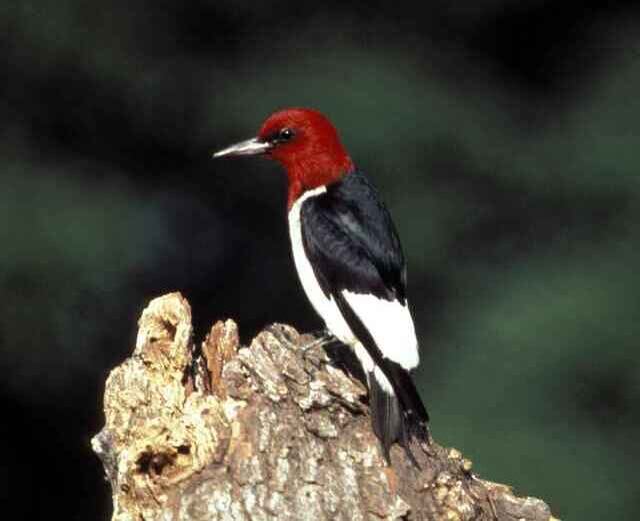
Attracting Them to Your Yard
The successful attraction of red-headed woodpeckers to your yard requires the provision of suitable habitat, the consideration of bird feeder preferences, birdbaths, and nest box considerations.
Suitable habitat for red-headed woodpeckers includes open woodlands, orchards, and forest edges with dead trees or snags for nesting and foraging.
When it comes to bird feeders, red-headed woodpeckers prefer suet feeders with a variety of insects, fruits, and nuts.
Additionally, providing nest boxes with appropriate dimensions and positioning them at least 10-20 feet above the ground can increase the likelihood of attracting these woodpeckers to your yard.
Providing suitable habitat
Providing a suitable habitat is crucial for the red-headed woodpecker to thrive and fulfill its ecological role.
This woodpecker species has specific ecosystem requirements that must be met in order for it to survive and reproduce.
Red-headed woodpeckers are typically found in open areas with scattered trees, such as woodlands, savannas, and orchards.
They prefer habitats with dead trees or snags, as these provide nesting sites and a reliable food source of insects.
Additionally, they have specific foraging behaviors, such as catching insects in mid-air or excavating tree trunks for hidden larvae.
They also exhibit migratory patterns, with some individuals traveling long distances to find suitable breeding grounds.
Understanding its habitat preferences and behaviors is essential for conservation efforts and ensuring their long-term survival.
Transitioning to the next section, their bird feeder preferences include suet, peanuts, and sunflower seeds.
Bird feeder preferences
To cater to the red-headed woodpecker’s dietary preferences, bird feeders can be stocked with suet, peanuts, and sunflower seeds, enticing these birds with a delectable feast.
Red-headed woodpeckers have a varied diet that includes insects, fruits, nuts, and seeds. They are known to visit different types of bird feeders, including hopper feeders, platform feeders, and suet feeders with some suet cakes that woodpeckers love.
Hopper feeders provide a convenient platform for them to cling to while they access the food.
Platform feeders offer a larger feeding area, accommodating multiple birds at once. Suet feeders provide a high-energy food source, which is especially beneficial during colder months.
It is important to place the feeders in a quiet and secluded area, away from predators and disturbances.
Additionally, using squirrel deterrents such as baffles or placing the feeders on poles can help prevent squirrels from stealing the woodpeckers’ food.
By providing suitable bird feeders and placement, not only can red-headed woodpeckers be attracted, but other bird species as well.
Transitioning to the next section, nest box considerations should also be taken into account to further support these birds’ habitats.
Provide a birdbath
Create a welcoming oasis for red-headed woodpeckers in your garden with an affordable birdbath, conveniently available on Amazon.
By offering a reliable water source, such as a birdbath, you can entice these beautiful birds to visit and stay.
Red-headed woodpeckers, like many other avian species, require water for drinking and bathing.
Providing them with a dedicated birdbath ensures they have access to clean and fresh water, enhancing their well-being while offering you an opportunity to observe their fascinating behaviors up close.
With a quick visit to Amazon, you can easily find an affordable and suitable birdbath like this one to transform your outdoor space into a haven for red-headed woodpeckers.
Plant Trees and flowers
To attract red-headed woodpeckers to your garden, consider incorporating suitable trees and flowers into your landscape.
Planting trees like oak, beech, hickory, and fruit-bearing varieties can provide nesting sites, food sources, and perching opportunities for these woodpeckers.
Additionally, incorporating flowers such as sunflowers, coneflowers, and bee balms can attract insects, which serve as a vital part of the woodpeckers’ diet.
By creating a diverse and bird-friendly environment, you can increase the chances of attracting these captivating birds to your yard and enjoy their presence amidst the beauty of nature.
Nest box considerations
Create the perfect habitat for red-headed woodpeckers and boost their reproductive success with careful nest box considerations.
Discover an effortless solution with a purpose-built nest box, like this one available on Amazon, inviting these magnificent birds to your backyard.
When selecting a location for the nest box, prioritize protection from predators and harsh weather. Place it 10 to 20 feet high on a live tree.
Opt for a design with a small entrance hole to prevent larger birds from taking over. Maintain the nest box regularly to ensure cleanliness and prevent parasite infestations.
Monitoring occupancy rates provides insights into breeding success while considering competition from other cavity-nesting species when determining the number and placement of boxes.
Now, let’s dive into the intriguing feeding habits that make red-headed woodpeckers truly exceptional.
Interesting Red-headed Woodpecker Facts
- High Acrobats: Red-headed woodpeckers are exceptionally skilled at acrobatic maneuvers. They can hang upside down from branches, scale tree trunks with ease, and even perform aerial flips during courtship displays.
- Food Storage Masters: These woodpeckers have a unique habit of storing food. They often stash surplus food, such as insects and seeds, by wedging them into crevices in tree bark or even impaling them on thorns, creating “pantries” to sustain them during harsh weather or scarcity.
- Drumming Dialects: Red-headed woodpeckers have distinct drumming patterns that vary between individuals and regions. These drumming sounds serve as a form of communication, helping them establish territory boundaries and attract mates.
- Intense Caching Behavior: When caching food, red-headed woodpeckers are known to cover their caches with bits of bark, lichen, or even leaves. This behavior not only helps conceal their food from potential thieves but also protects it from spoiling under intense sunlight.
- Vocal Mimics: Red-headed woodpeckers have impressive vocal abilities and can mimic the calls of other bird species, including hawks, jays, and even songbirds. This mimicry may serve as a defense mechanism, confusing potential predators or competitors.
- Nest Site Selection: Unlike many other woodpecker species, red-headed woodpeckers prefer to excavate their nest cavities in living trees rather than dead ones. They often choose large, healthy trees with softer wood, which allows for easier excavation.
- Territorial Defense: Red-headed woodpeckers fiercely defend their territories from intruders, including other woodpeckers and cavity-nesting birds. They are known to engage in aggressive behaviors, such as chasing and vocalizing, to protect their nesting sites and feeding areas.
- Unique Plumage Variation: While red-headed woodpeckers typically have vibrant red heads, some individuals may exhibit variations in plumage. It is not uncommon to find individuals with partially or entirely black heads, which adds to the intrigue and diversity within the species.
- Cultural Significance: Red-headed woodpeckers hold cultural significance in some Native American tribes, where they are considered symbols of strength and determination.
Frequently Asked Questions
What is the lifespan of a red-headed woodpecker?
The lifespan of a red-headed woodpecker typically ranges from 9 to 12 years, although some individuals have been known to live up to 15 years.
Do red-headed woodpeckers migrate long distances?
Yes, red-headed woodpeckers are known for their long-distance migrations. They undertake extensive journeys during the winter months, traveling southward to find more favorable feeding grounds. These migrations can span several hundred miles, with some individuals traveling as far as Central America for the winter.
How do red-headed woodpeckers communicate with each other?
Red-headed woodpeckers communicate with each other through various methods, including vocalizations, visual displays, drumming patterns, and behavioral signals. They use specific calls and displays to establish territory, attract mates, and communicate threats or warnings to other individuals.
Can red-headed woodpeckers be found in urban areas?
Red-headed woodpeckers can be found in urban habitats, where they have adapted their behavior to city environments. They face competition with other bird species and their populations are impacted by urbanization.
Why are Red-headed Woodpeckers important?
These birds have an important role in nature because they destroy the nests of many harmful insects like the tent caterpillar and bark beetle, preventing these pests from harming other animals or plants. Red-headed woodpeckers also control cockroaches by eating them for food!
Is a Red-headed Woodpecker rare?
The Red-headed Woodpecker (Melanerpes erythrocephalus) is considered a declining species, making it relatively rare compared to other woodpeckers. While it can be found across North America, its population has been decreasing due to habitat loss and changes in forest ecosystems.
Are red-headed woodpeckers considered threatened or endangered?
Red-headed woodpeckers (Melanerpes erythrocephalus) are not currently considered threatened or endangered. However, conservation efforts are necessary due to population decline caused by habitat loss. Their breeding behavior and ecological significance make them valuable indicators of ecosystem health.
Conclusion
In conclusion, the red-headed woodpecker is a fascinating avian species that captivates with its vibrant appearance and intriguing behaviors.
With its declining population, encountering these birds in the wild can be considered a special sighting.
By installing purpose-built nest boxes and creating a bird-friendly environment with suitable trees and flowers, you can actively contribute to attracting and supporting these magnificent woodpeckers in your own backyard.
Embrace the wonders of nature and enjoy the beauty of red-headed woodpeckers as they grace your surroundings with their presence.

